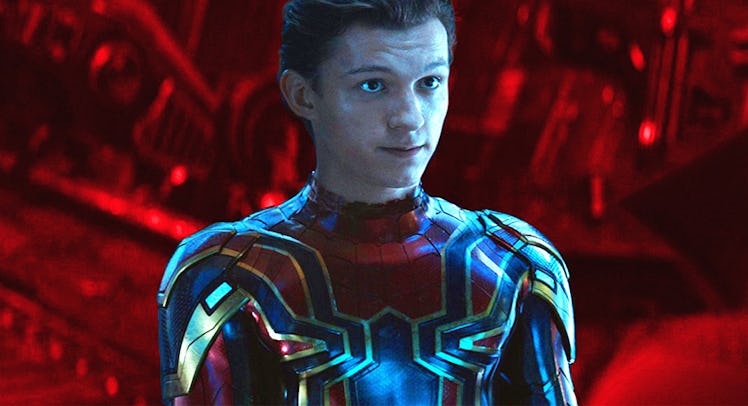‘Avengers: Infinity War’: Let’s Discuss that Spider-Man Scene
Let's discuss that Peter Parker scene in Infinity Wars. Yeah, you know the one.

Avengers: Infinity War, the most ambitious and face-punchiest Marvel property ever arrived this weekend and, while it was a fun, thoroughly satisfying ride, it was also pretty grim. Like, holy-hell-did-that-really-just-happen? grim. Because — MASSIVE SPOILER ALERT — the Avengers failed to stop Thanos from collecting the Infinity Stones and the big purple baddie was able to snap his fingers and remove half earth’s population. As a result, several superheroes crumbled to ash and blew away in the breeze. While all deaths were tough, perhaps the most gutting was that of Peter Parker, who, unlike others who crumbled quickly, was given the time to really feel his body crumbling away as he laid in Iron Man’s arms. This begs the question: what the hell Marvel?
First, some background: On Titan, Ironman, Starlord, Drax, Mantis, Dr. Strange, and Spiderman all battle Thanos in an attempt to wrestle his gauntlet, which holds the Infinity Stones he’s collected so far, off of his arm. At some point, he’s restrained by all of them and Mantis has forced him to sleep as they try to get the gauntlet. Their efforts are thwarted when Starlord learns that Thanos has killed Gamora, and, in a fit of rage, attacks Thanos. The battle devolves. Ironman has a near brush with death when Thanos stabs him, Dr. Strange, who, from his time-skipping mental adventures knows something no one else knows about how the future battle plays out, gives up the Time Stone in to save him, and Thanos returns to Earth to get the final stone from Vision.
Thanos is very clearly far more powerful than any Avenger, Infinity Stones or not. But that’s not for lack of fighting. In one last ditch effort, Thor attempts to kill Thanos and very nearly succeeds by throwing his sweet new axe, Stormbreaker, into his chest. But Thanos, hands still free, is able to snap his fingers. All around him superheroes and standard warriors alike turn to dust: Bucky, Groot, Black Panther, countless Wakandan warriors, the Scarlet Witch, all turn to ash. As it happens, they all appear surprised, but they do not appear to feel any pain. Black Panther doesn’t even have time to comment on his disappearing form.
But the same is not true in space. Although Drax, Starlord, and Dr. Strange all become dust — Dr. Strange cryptically stating that this was the only way they could survive — it is Peter Parker’s death that hits the hardest. He is aware, for certain, of what is happening. Stumbling to Stark, Parker utters, “Mr. Stark, I don’t feel so good.” It is possible that his Spidey-senses have given him an awareness that no other hero has. The sixteen-year-old clutches Parker, who then says, “I don’t want to go,” and as he falls to the ground he apologizes one more time for “failing” Stark.
It is a haunting scene, and Tom Holland, who portrays Parker, gives a deeply affecting performance. His death hits particularly hard, because not only is there a solidified relationship between Stark and Parker, cemented in the most recent Spiderman movie, not only because the death is physically and emotionally painful for Parker himself, not only because Parker is just a kid, but also because it’s very clear that their budding mentor/mentee relationship opened up a brand new world of possibility for Stark. We catch just a small glimpse of that possibility at the beginning of the movie: before the arrival of Thanos’ henchmen, Stark and Pepper Potts talk about starting their own family.
And then he’s whisked away to fight for the fate of the universe, family on hold. Parker, the way Parker always does, tags along and inserts himself into the danger that Stark, who became a mentor figure to Parker, has consistently attempted to keep him out of, what, with Spiderman only being a teenager. But he can’t, because Parker is a hero and he’s headstrong — a lot like Ironman himself, who shuts off his communication device when Pepper begs him to come back home.
Stark loses a lot in one day: His possible future with Pepper. Half of the universe. And the closest thing he has to a son. And while Parker will totally be back, not only in a standalone Spiderman sequel, but in next year’s untitled Infinity Wars sequel, his death stings. After all, he’s the only one who is aware of what is happening. He apologizes for his failure. Tony Stark, the person he has leaned on to keep him safe, can’t save him. And after all, it is painfully clear that Parker really is only a teenager. And teenagers — even if they are heroes — don’t deserve to die.
While this is an emotional arc that the Russo brothers and Marvel wanted to have, it still begs the question: Why do this to kids in the audience? Spider-Man is a fan favorite of little kids everywhere. And to make his death the longest and most grueling of them is a very specific choice. Sure it works for the movie, but at what cost? The audience of Marvel movies is, yes, adults. But it’s also kids. And many kids don’t have the ability to really grasp that there are more Marvel movies in the works and that Holland has a long contract to see him through, oh, 56 more Spidey movies. All they know is that Spider-Man crumbled to dust. That’s a lot of a kid to take and one that Marvel and Disney need to consider. Yes, their movie had an emotional punch. But at what cost?
This article was originally published on